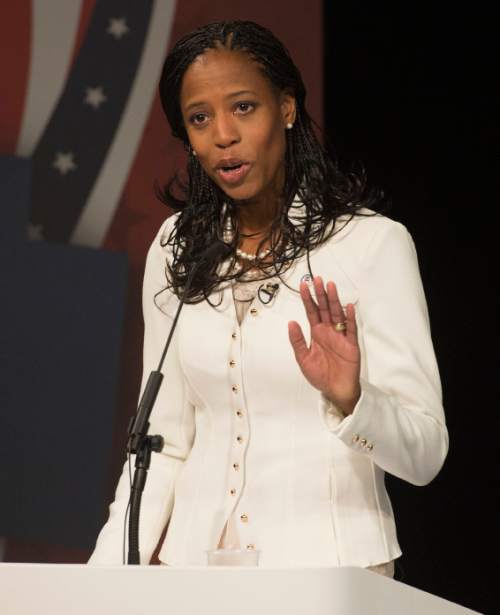This is an archived article that was published on sltrib.com in 2016, and information in the article may be outdated. It is provided only for personal research purposes and may not be reprinted.
The campaign ad blitz starts now.
First-term Rep. Mia Love and her Democratic opponent, Doug Owens, are launching sustained TV advertising campaigns in what is expected to be one of the state's closer election contests.
Not only are the 4th Congressional District candidates going on air a week before Labor Day, which has traditionally been the start of the election season, but they've also more than doubled what they spent on TV ads during their 2014 showdown.
Love is spending at least $1,161,000, while Owens is spending at least $690,000, according to filings with the Federal Communications Commission. That will translate into more than 5,000 ads over the next 10 weeks.
Why such an aggressive start?
It's likely a combination of factors. For one thing, most of Utah's counties have moved to mail-in ballots, meaning many voters can turn in their ballots two weeks before Election Day, which is Nov. 8.
Also, in their rematch, Owens has raised more money and has the backing of the Democratic Congressional Campaign Committee, allowing him to be more aggressive, noted Tim Chambless, a political scientist at the University of Utah.
The third factor, said Chambless, is the presidential race, which is likely to grab most of the attention in the race's final weeks.
"It seems to me that both candidates are trying to get a headstart before the large media buys begin after Labor Day, maybe not until October, for the big statewide races," said Chambless, who also works with the U.'s Hinckley Institute of Politics.
Unlike in 2014 when Love defeated Owens by about 5 percentage points, this campaign season has a dramatic and contentious presidential race along with statewide contests for governor and senator. The 4th District covers the west side of Salt Lake and Utah counties and portions of central Utah.
Love's first ad, which began running Monday, features seven supporters who call her a "fighter," a "straight shooter" and "bipartisan," and says she's spent her first two years in Congress working to protect jobs, support education and safeguard the benefits of veterans.
"The message we had in there is that people like the job she is doing and she is producing for them," said Dave Hansen, her campaign manager.
Owens' first ad, which also launched Monday, focuses on his great-grandfather's pioneer history. "Imagine walking 1,000 miles, barefoot across the open Plains." Owens says that the pioneers survived by working together and that Utahns still follow that example.
"The story in Washington is different," he said. "Politicians there just look out for themselves."
That's as close as he got to criticism of the incumbent. These early ads are likely to remain positive, but Chambless said to expect the candidates to start attacking each other in the weeks to come because the vast majority of TV campaign ads nationwide are negative.
Utahns who watch TV news will definitely see the campaigns' spots, which will also run during select prime-time shows and during a few NFL football games.
Taylor Morgan, Owens' spokesman, said the Democrat will once again highlight his Utah roots because that message resonates with voters.
"It demonstrates his commitment to Utah, Utah values and putting Utah first in Congress," he said.
The race is one attracting interest far beyond the state's borders as Democrats seek to shrink the Republican majority in the U.S. House.
The only outside group that has reserved ad time is the Democratic group House Majority PAC, which has locked up $380,000 in advertising in the final weeks of the race. Hansen said he doesn't expect any Republican groups to weigh in, and he's not convinced the Democratic groups will either.
That would happen only if the race is seen as close — such as the nail-biter in 2012 when former Rep. Jim Matheson defeated Love by 768 votes.
In that contest, outside groups and the candidates spent more than $10 million combined.
The most recent public poll, conducted two weeks ago by Dan Jones and Associates for UtahPolicy.com, found Love with a 13-percentage point lead, while a Salt Lake Tribune-Hinckley Institute poll from June found Owens ahead by 6 points.
Chambless said he expects it to be close.
"The race is really fluid," he said. "And either candidate can win."
Twitter: @mattcanham



